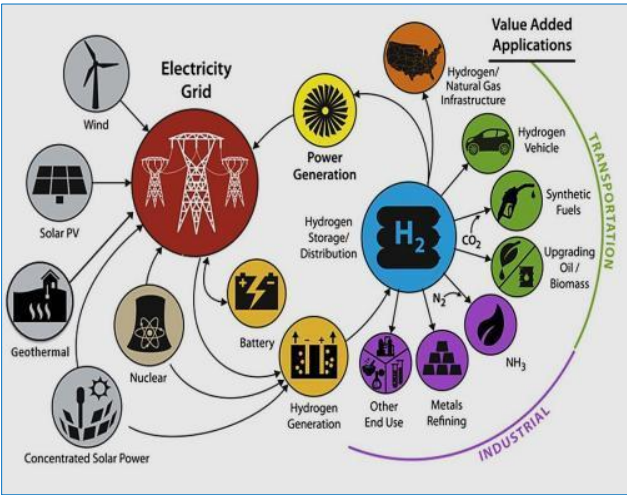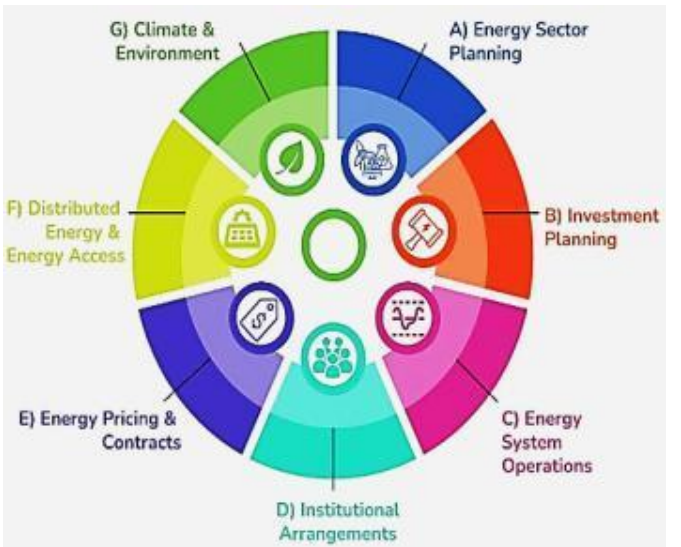Seminar "Road of energy transition towards 100% renewable energy and Net Zero goal for Vietnam", August 29, 2023, Ho Chi Minh City. HCM
Associate Professor, Dr. Pham Hoang Luong
Senior lecturer, School of Mechanical Engineering
Director, Vietnam - Japan International Institute of Science and Technology
Email: luong.phamhoang@hust.edu.vn
KEY RESULTS SCENE 100% NLTT
Industry-wide energy data and structure of energy use in 2050

|
Industry ▪ 80% Renewable Energy scenario: ✔ Total Final Energy Consumption (TFEC): 116.8 MMTOE
✔ TFEC: 117.4 MMTOE
|
|
Transportation industry ▪ 80% Renewable Energy scenario: ✔ TFEC: 54 MMTOE
▪ 100% renewable energy scenario: ✔ TFEC: 48 MMTOE
|
Power industry ▪ 80% Renewable Energy scenario: ✔ Total installed capacity: 1,100 GW
▪ 100% renewable energy scenario: ✔ Total installed capacity: 1,350 GW 100% from renewable energy ✔ Energy Storage: 200GW and 1050GWh |
Two key strategies to achieve the goal of 100% renewable energy: i) Electrification combined with improving energy efficiency, ii) Renewable energy combined with energy storage
New and modern technologies in renewable energy and fuel are expected to be used for the 100% RE scenario from 2030 and fully utilized by 2050.
|
▪ For energy-using industries: ✔ Industrial: electrification, heat pumps for low and medium temperature applications, biofuels/renewable fuels for sectors/subsectors difficult to electrify Transportation: tram; biofuels/renewable fuels for heavy trucks, shipping and aviation; Household, commercial and agricultural: electrification, biofuels/renewable fuels. ▪ For the electricity industry: ✔ No new coal industry enterprises from 2026; Closure of coal-fired power plant Developing offshore wind power; Energy storage (including ammonia and green hydrogen). |
 |
POLICY Roadmap to Implement 100% Renewable Energy
| ENVIRONMENT | ADMINISTRATION | |||
|
Energy Carbon Water Using land Biodiversity Resources (Important raw material) Safety and contamination risk |
|
Political situation Multidisciplinary + multi-level cooperation Transparency + Rule of Law Business environment Ownership Stakeholder engagement |
||
| ECONOMY | Scenario 100RE | SOCIETY | ||
|
Decoupled growth (economic growth decoupled from environmental degradation) Employment Local added value Energy mix Innovation, R&D, Technology Transfer The infrastructure Circular Economy |
|
Energy Poverty + Access Human Rights Labor Standards Occupations, Skills, Training Health and Safety Just Transition |
GENERAL RECOMMENDATION (FOR ALL 2022-2050)
Energy sector planning: policies to integrate renewable energy sources, expand the power grid to transmit electricity from areas rich in renewable energy resources to areas with high electricity demand...
Investment planning: offshore wind power investment, etc.
Energy system operation : better integration of energy storage (BESS) into the power system, etc.
▪ Institutional structure: monitoring and reporting, standards development, etc.
Energy pricing and contracts: flexible rewards, green certificates, etc.
Energy access and distributed energy: encourage electrification and EV adoption by providing financial support to early adopters, etc.
▪ Climate & Environment: integrating climate policies, carbon emission reduction strategies and achieving Nationally Determined Contribution (NDC) targets

SPECIFIC RECOMMENDATION (FREE PURPOSE 2022-2030)
Specific recommendation 1: Integrate renewable energy development into the electricity industry
Specific recommendation 2: Electrify the transportation sector
Specific recommendation 3: Offshore wind power development
Specific Recommendation 4: Integrate climate change goals with Vietnam's NDC .
Specific recommendations 1. Integrating RE development into the power sector
Table 1. Identifying prerequisites for integrating renewable energy development into the power sector and related challenges
| Prerequisites | prerequisites Current status and new challenges |
| Ability to maintain and enhance electrical system reliability and security |
Perform transmission expansion Period 2016-2020: Transmission grid development only completed 70-90% of the adjusted Electricity Planning VII targets, due to difficulties in site clearance and lack of investment In 2020, Trung Nam Group was the first private investor to develop a 500 kV ultra-high voltage power transmission line for a 450 MW solar power project. Operating the power system in the context of a high proportion of renewable energy In 2020, the proportion of renewable energy in Vietnam's total power capacity is approximately 30%, but the proportion of renewable energy in electricity production is only equal to 12% of national electricity output; Implement reduction of renewable energy due to overload of power transmission lines Development of an energy storage system o No energy storage system has worked so far
|
Table 2. Actions to achieve identified prerequisites for integrating RE development into the power sector
| Prerequisites | In process | Proposed action should be taken soon |
| Ability to maintain and enhance electrical system reliability and security |
The Ministry of Industry and Trade is reviewing the list of projects related to investment in upgrading inter-regional and intra-regional power transmission lines for the period up to 2030.
EVN deploys Bac Ai pumped storage hydroelectric storage tank (300MW x 4 units) to meet the commercial operation deadline ( 2029) |
Amend/adjust the Law on Forests, Land, Sea and resolutions and decrees related to land valuation, conversion of forest land and agricultural land to energy land;
Adjust the Electricity Law to allow private renewable energy investors to participate in construction and development of power transmission grids.
Promote R&D in energy storage technology (Storage hydroelectricity and BESS); Develop financing options for promoting energy storage systems and technologies in Vietnam.
|
Specific recommendations 2. Electrification of the transport sector
Table 3. Identification of prerequisites for electrification of the transport sector and associated challenges
| Prerequisites | Current situation and new challenges |
| Possibility to switch to electric vehicles for passenger transport |
Develop infrastructure for electric vehicles In 2021, VinFast becomes the first private corporation to produce and launch electric vehicles in Vietnam; The trend of using electric vehicles in passenger transport has changed Developing regulations for electric vehicle development in Vietnam Decision No. 876/QD-TTg dated July 22, 2022 of the Prime Minister on the Action Program to convert green energy, reduce carbon and methane emissions in the transport sector Official letter of the Ministry Transport No. 3686/BGTVT-KHCN&MT dated April 13, 2023 to the central provinces and cities on the formulation and approval of specific plans and tasks to implement Decision No. 876/QD-TTg. |
Table 4. Actions to achieve identified prerequisites for electrification of the transport sector
| Prerequisites | In process | Proposed action should be taken soon |
| Possibility to switch to electric vehicles for passenger transport | The Ministry of Transport is reviewing the action plan issued by Thai Nguyen province (No. 105/KH-UBND dated May 30, 2023), Quang Ngai (No. 139/KH-UBND dated August 31, 2022), Vinh Phuc (No. 157). /KH-UBND dated 24/5/2023) and other central provinces and cities submitted. | Develop financial incentives to promote early electric vehicle adoption Support the development of electric vehicle charging infrastructure through measures such as direct investments to install publicly accessible chargers |
Specific recommendation 3: Offshore wind power development
Table 5. Determination of prerequisites for offshore wind power development
| Prerequisites | Current status and new challenges |
| Ability to plan, bid and implement offshore wind power projects in Vietnam |
Development of Offshore Wind Power Planning in Vietnam: Offshore wind power planning in Vietnam must be consistent with the National Marine Spatial Plan;
Identify potential areas for wind power development; Ensure good use of energy sources, while reducing impacts on marine ecosystems and avoiding conflicts with other marine economic sectors; To date, the National Marine Spatial Plan for the period 2021-2030 has not yet been approved.
- Design/selection of rapid development or tender mechanisms to start offshore wind power in Vietnam (7GW by 2030) Fast development mechanism: choose a large-scale pilot project or apply a special set of mechanisms for a certain capacity (3 - 4 GW) to develop projects in a shorter process. This mechanism helps support the rapid implementation of projects to address policy barriers; achieve a large enough deployment scale to reduce electricity generation costs; Projects do not have to wait for the Marine Spatial Planning or bidding process to be developed and appraised. Main challenges: how to choose good projects with competent developers; Bidding mechanism: has the advantage that the project development process is open, transparent, competitive and effective, but according to experience in most countries, implementing this mechanism is really time-consuming; Up to now, the relevant ministries have not made any clear decisions on offshore wind power bidding |
Table 6. Actions to achieve identified prerequisites for offshore wind power development
| Prerequisites | In process | Proposed action should be taken soon |
| Able to plan, bid and implement offshore wind power projects in Vietnam | MONRE is reviewing the National Marine Spatial Planning; Power planning 8 was approved by the Prime Minister on May 15, 2023. | o The national marine spatial plan will be approved by the end of 2023 or early 2024; The Ministry of Industry and Trade develops criteria for selecting offshore wind power investors (as prescribed in Article 16 of Decree 25/2020/ND-CP) |
Specific Recommendation 4: Integrate sector-wide climate change targets with Vietnam's nationally determined NDC contribution targets
Table 7. Identifying prerequisites for integrating climate change goals with Vietnam's NDC goals
| Prerequisites | Current situation and new challenges |
| The ability to synchronize climate change goals with Vietnam's NDC goals |
Developing a National Strategy on Climate Change: Decision No. 896/QD-TTg dated July 26, 2022 of the Prime Minister approving the National Strategy on climate change until 2050; Develop an action program to implement the National Strategy on Climate Change: Vietnam's NDC targets were submitted to the United Nations Framework Convention on Climate Change (UNFCCC) on November 8, 2022;
Decision No. 876/QD-TTg dated July 22, 2022 of the Prime Minister on the Action Program for green energy conversion, reducing carbon and methane emissions in the transportation sector;
Decision No. 2756/QD-BCT dated December 14, 2022 of the Minister of Industry and Trade promulgating the Action Plan to respond to climate change and green growth for the Industry and Trade sector in the period to 2030, with a vision to year 2050;
Decision No. 70/QD-BGTVT dated February 3, 2023 of the Minister of Transport on approving the detailed plan to implement the project to support the Ministry of Transport to implement NDC within the framework of the Project "Transportation Initiative". transportation in NDC in Asian countries" 2023
|
Table 8. Actions to achieve identified preconditions for integrating climate change goals with Vietnam's NDC targets
| Prerequisites | In process | Proposed action should be taken soon |
| The ability to synchronize climate change goals with Vietnam's NDC goals | The Ministry of Industry and Trade is reviewing the National Master Plan for the period of 2021-2030, with a vision to 2050 |
Other relevant Ministries (Ministry of Agriculture and Rural Development, Ministry of Construction, etc.) develop corresponding action plans/programs in accordance with Vietnam's NDC goals; Action plans prepared by the Ministry of Industry and Trade and the Ministry of Transport will be implemented on schedule with expected results. |





